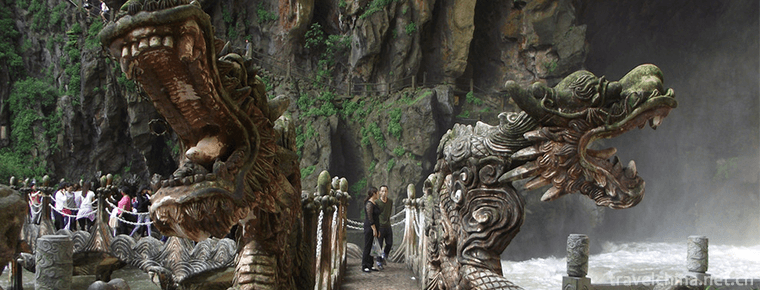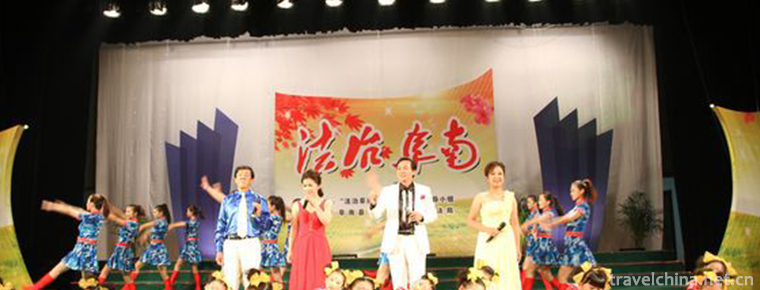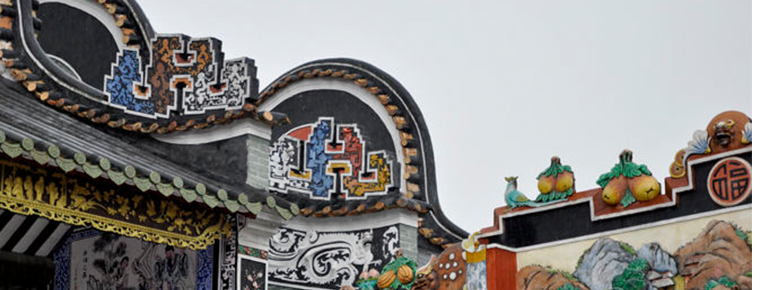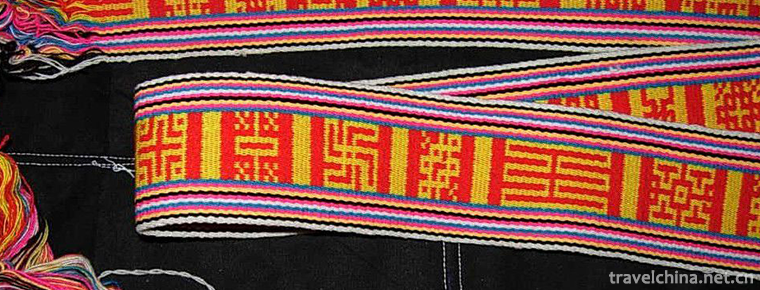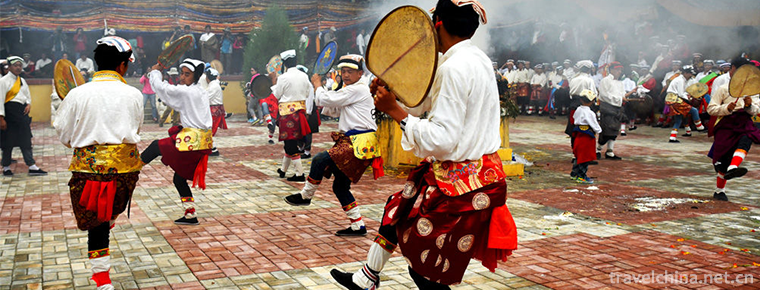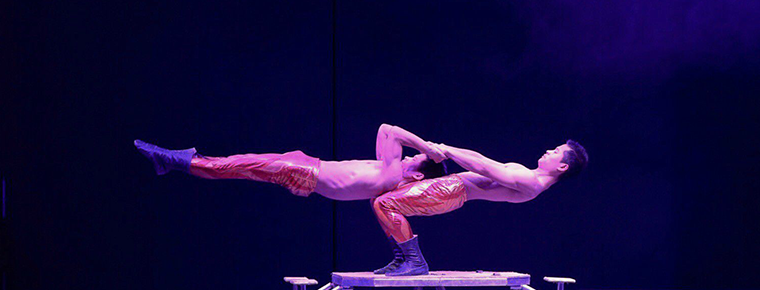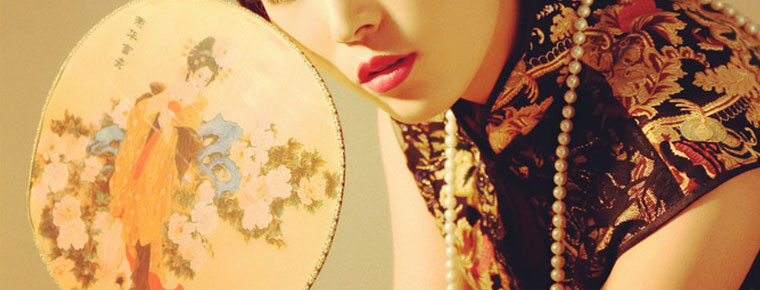Xiangyuan Drum Book
Xiangyuan Drum Book
Xiangyuan Drum Book is a traditional opera in Shanxi Province. Originated in Xiangyuan, Shanxi Province, it is popular in Shangdang area. It is also called Guer Ci and Xiangyuan Tune. According to legend, in the early years of Qianlong in Qing Dynasty, Xiangyuan blind artists set up the "Three Emperors'Club" to teach drum scripts and hexagrams, so that the drum CI can be passed down from generation to generation, and the tune is constantly enriched and reformed. The early performances were bookdrums supported by low wooden shelves. The singer played the festival of drag boards and drums and arrows, while the other played the accompaniment of Laohu or Erhu. There are only two kinds of arias: Adagio and allegro.
On June 7, 2008, the "Xiangyuan Drum Book" declared by Xiangyuan County of Shanxi Province was approved by the State Council and listed in the second batch of national intangible cultural heritage list. Heritage serial number: 755 V-62.
Historical Origin
Xiangyuan Drum Books, commonly known as "pedal bangs", are mainly distributed in Xiangyuan County and adjacent Qinyuan, Wuxiang, Tunliu and other places. It was formed on the basis of the local "Liu Diao" and "Guer Ci" in the late 1930s. At the beginning of the founding of the People's Republic of China, it was called the Xiangyuan Drum Book. "Guer Ci" was inherited from the same name form since Song and Yuan Dynasty, but developed and changed. Liu Diao flourished in Yongzheng Period of Qing Dynasty. It was said that it originated in Xiying Town of Xiangyuan County and was originally called "Ying Ge Liu". During the Guangxu period, Tian Wei, an artist from Shanfu Township of Xiangyuan County, fused the folk brothel Liuxiang Qingge and local folk song minor tunes on the basis of the original tunes, making the "Liuxiang Tune" more melodious and melodious, with various colors and rich expressive force. Since then, people have changed its name to "Yinggeliu Tune", commonly known as "Liuxiang Tune".
In the early years of the Qianlong reign of the Qing Dynasty, there were activities of folk performing groups composed of teachers and apprentices. During the Daoguang period, artist Shi Jinxing absorbed local minor, Taoist "Huayuan tune" and folk Hawking tune in his rap and singing performances, which enriched the singing tone of drum words. In the early years of Xianfeng, Shi Jinxing's apprentice Lu Yongquan transplanted and compiled some of them on the basis of traditional folk stories and myths. A series of long books, and absorbed some local operas and Luozi, Yangko singing tunes, so that the singing music is more rich and beautiful. Later, on the basis of the original singing method, Miao Xilai, a blind artist, created the "tragic board" and "grabbing board" functional singing tunes.
In the early period of the Republic of China, Duan Minghe, the fifth generation descendant, made great efforts in rapping and singing "Guzi Ci", further enriching the singing music of "Guer Ci", and making the style of the singing more stable. During the Anti-Japanese War, local Xiangyuanggu calligraphers spontaneously formed a patriotic propaganda team to publicize and save the nation. Xiangyuan Drum Book is a kind of folk drum book form, which is mainly composed of singing and speaking in Xiangyuan dialect vocabulary. Xiangyuan Drum Books are usually performed in cooperation with many people. As the palm of the performance, the drummer can use both hands and feet. One person can operate a set of percussion music, such as flat drum, hexagram board, wooden fish, foot bangles, gongs, cymbals, boring gongs, and foot-beating gongs. The rest of the rappers should rap in their branches according to their own conditions and content. Or turn-by-turn rap, or lead the crowd, or two people to sing in pairs, or singing in chorus; single performers only play the lyre by themselves; two performers play the lyre and octagonal drum by themselves. The stage movements of Xiangyuan Drum Books usually take the form of sitting and singing, as well as standing and walking singing. Compared with other drum books of the same kind, its performance, especially singing, is more abundant. It almost includes all kinds of singing methods in the vocal music system. It includes not only Solo singing, duet singing and rotation singing, but also lead singing, accompaniment singing, chorus singing, grab singing and band singing, etc. It is very rich.
Performing Form
The singing tune of Xiangyuan Drum Book belongs to the structure of plate-cavity variation. There are two kinds of tunes: Guer Ci and Liu Diao. They are commonly used in alternation, sometimes only one of them. Guer lyrics are mainly composed of big board, scrambling board, scattering board, crying board and so on. The singing form of Liu Diao is that one person plays octagonal drums with one hand and the other accompanies with the moon piano and performs in pairs.
Xiangyuan Drum Book is mainly composed of sitting and singing. When singing a long book, many people are assigned to the main characters, and the plot and characters are expressed by solo, duet and chorus. The singers are divided into four parts: Beijing Hu, Erba, Hu Hu and Yueqin. The number of people can be added to Sanxian, Erhu, Zhonghu and so on.
It evolved from Song and Jin Drum Ci. In the early years of Qianlong in the Qing Dynasty, Xiangyuan blind artists set up the "Three Emperors'Club" to teach drum calligraphy skills. It has been handed down from generation to generation and has been enriched and reformed in tune. The early singing forms of Xiangyuan Drum Book are as follows: a low wooden shelf is placed on the table to support the book drum, the singer plays the board, the drum key festival, the other one plays the accompaniment of Laohu or Erhu, and the singing tune is only slow board and fast board.
During the reign of Qingdaoguang, blind artists absorbed local folk tunes and Taoist tunes, enriched the original music cards and enriched the expressive force of singing. During the Xianfeng period, blind artists absorbed Dangbangzi, Shangdang Laozi and Yangko singing tunes in local operas, and made great progress in melody and style. At the end of Qing Dynasty and the beginning of Republic of China, Duan Xiaowu, a blind artist, created and increased the starting board, duality, palletizing board and cutting board, and transformed the grabbing board into the grabbing board and slow grabbing board, so as to enrich and improve the form of Guer Ci. Later, someone created the "turning board" from drum Ci to opera. In addition to the original drums and bookboards, percussion accompaniment adds gongs, big hairpins, boring gongs, small gongs, bangles and so on. However, it is operated by one person, with both hands and feet. The whole set of gongs and drums has a tight rhythm, a strict size and a lively atmosphere, which basically finalizes the singing tone and the pattern of the drum lyrics.
Traditional Bibliography
Because of its long history and rich traditional bibliography, Xiangyuan Drum Books have more than 30 volumes, such as Biography of Five Ladies Xingtang and Record of Golden Whip. The middle part includes more than forty parts, such as Yang Qilang's Dazhao and Gaowen Ju Suhua Pavilion. There are more than eighty passages, such as "Little Two Sisters Dreaming", "Little Two Populations Striving for Lamps", "Poor Man's New Year", "Huang Li Fan" and so on.
Main features
Detailed description of features
Singing tunes can be divided into two categories: drum Ci and Liu tune, which belong to the structure of plate style. In general, two kinds of singing tunes can be used alternately or only one of them can be used. Guer lyrics are mainly composed of adagio, grabbing board, scattered board, crying board, etc. Liuyu lyrics are mainly composed of flat board, and there are also drum board, small crying board, scattered board and transition board of starting, sending and guiding. When singing short pieces, one singer is the lead singer. Artist Dong Caiyuan can sing with gongs, cymbals, cymbals, wooden fish, drum boards and other nine percussion instruments, as well as string accompaniment. When singing a long drum book, many people sit and sing, sharing the roles of Sheng, Dan, Jing and Ugly. They express their feelings and portray the characters in the form of solo, duet and chorus. The performers are divided into four parts: Jinghu, Erba, Huhu, Yueqin and so on. They can also add three strings, Erhu, Zhonghu and Lower Hu. Percussion music includes single skin drum, sandalwood, board drum, wooden fish, bell touching, gongs, cymbals, bangs and so on.
Digging and sorting out
After the outbreak of the War of Resistance Against Japan, artists, under the influence of the anti-Japanese democratic government led by the local Communist Party of China, automatically dissolved the "Three Emperors'Club", established a patriotic propaganda team for the blind, and compiled new songs such as "Da Duan Village", "Blood and Tears Hatred", which played a role in encouraging the masses to participate in the anti-Japanese activities. After the founding of the People's Republic of China, the Xiangyuan Drum Books were comprehensively excavated and sorted out.
Performing methods
The traditional performances of Xiangyuan Drum Book are as follows: one person, two or more people share drums, boards, gongs, cymbals and two handles, two reeds, Huhu hu, yueqin, three strings, octagonal drums, erhu, flute, Sheng and other musical instruments, accompanying by themselves, performing between rap and singing. Among them, there are many ways of singing, such as solo singing, rotating singing, duet singing, lead singing, chorus, accompanying singing, etc. According to different occasions and needs, there are also various stages of action such as sitting, standing, walking, etc. Some skilled apprentices (palm drummers) can play flat drums, hanging boards, ankles, gongs, boring gongs, bangles, wooden fish, cymbals, cymbals, panic wood and other percussion.
The music of Xiangyuan Drum Book is unique and rich. It is composed of two systems, the early traditional "drum tune" and the later "liu tune", and belongs to the type of slab cavity. So far as the performance and inheritance of art are concerned, the two systems still have their own emphasis and systems. Its music aria not only has a variety of singing methods such as fast, slow, stamp, grab, but also has the functions of crying, sadness, joy, anger and so on. And there are many kinds of board, such as lifting board, bisexual board, tight board, slow board, loose board, and more than a dozen commonly used instrumental accompaniment and playing cards. In the long-term development and evolution, it gradually absorbed local minor tunes, Taoist tunes, folk Hawking tunes, Bangzi, Laozi, Yangko and other singing elements, which were deeply loved by the local people.
Artistic Characteristics
The content of Xiangyuan Drum Book mainly comes from the folk, which is easy to understand and rich in local flavor, reflecting the rich local customs. Such as "Wish Book" and "God Book". For example, Xiangyuan Drum Books are invited to help or serve as ceremonies for local temple fairs, birthday celebrations, full moon, weddings, funerals, warming houses, etc. Xiangyuan Drum Book Art is mainly inherited by oral transmission of teachers and apprentices. It is taught by single teacher and leaflet apprentices. Up to now, it has been handed down for nine generations. Early artists mainly engaged in storytelling and also in hexagrams.
In order to protect and inherit their own art, Xiangyuan Drum Calligraphy Artists invented and formed a unique "secret language" called "tune" in their long-term historical development, commonly known as "tune gimmick". It is a special jargon term for internal communication. In the past, it was mainly used among blind artists of "Guer Ci", "Liu Diao" and "Mingyuan" artists. Xiangyuan Drum Book not only carries the local people's understanding, ideals, wishes and interests of life, but also contains a large number of local social ethics and common sense of life, making Xiangyuan Drum Book.
Main structure
Xiangyuan Drum Book belongs to the complex structure of plate and cavity. It has many types of plate, beautiful melody and rich content. It is good at narration and lyric. Most of the practitioners are blind. When accompanying, one person operates a full set of percussion instruments and many people play strings.
In 1998, after watching the performance of Xiangyuan Drum Books by the "Caifeng" Troupe of the Chinese Musicians Association, it was highly praised. The famous composer, Mr. Sheng Mao, called it "Chinese rock music".
Xiangyuan Gushu Music Research Expert, 1985 Editorial Board of "Chinese Quyi Music Integration Shanxi Volume" (Changzhi Collection), Professor Wang Dechang; Xiangyuan County Library Director, local famous Yangko opera actor Korea Jun; Xiangyuan County Quyi Team current captain Li Qi; original Quyi Team business captain, local famous veteran artist Wang Junchuan, Quyi Team actors Jia Fuming, a well-known local artist, as well as Wang Xianping, Yu Huancheng, Hao Shuicheng, Cao Yanming, Zhang Junhua, Shen Sulan, Lu Shuiqing, Ma Xingping, Yu Fangfang and other young and middle-aged performers. Watching performances, recording and video recordings, collecting and studying materials, comparative studies and so on, in order to objectively display the whole picture of Xiangyuan Drum Book as far as possible, find out the crux of its decline, and seek a "good recipe" for revitalizing Xiangyuan Drum Book (as well as folk songs in the same situation).
Singing instruments
Vocal structure
Xiangyuan Drum Book has gone through three stages of development, namely, mono-melody, basic melody, plate-cavity variation and plate-cavity complex. The so-called plate-cavity complex is a complex structure which inserts other curved cards on the basis of the plate-cavity.
(1) Basic board type
1. Guer Ci, also known as Daban, is one of the oldest and most basic forms of Xiangyuan Drum Book. One-sided, 2/4 notation, case for seven-character sentences or cross sentences, the structure of the upper and lower sentences, all fall 5 tones. Because of the change of rhythm and speed, it can be divided into three types: adagio, androgyny and tightness.
2. LiuDiao, originated from the folk melody Yinggeliu, has a slate without eyes, 1/4 notation, the case is seven-character sentence or cross sentence, the structure of upper and lower sentences, 1 or 6 tones of the upper sentence, 5 tones of the lower sentence. Because of the change of rhythm and speed, it can be divided into willow tune, tight willow tune and palletizing.
3. The long connection between grabbing the board, drum words or willow tunes is used to describe the scene, the structure of the upper and lower sentences, the upper sentence with 5 tones and the lower sentence with 1 tone. When singing, there is no accompaniment, no passage between sentences, only rhythm with bangles. Because of the different speed, it can be divided into slow and fast.
Slow grab board, multi-turn drum words of the adagio, androgyny board or willow tune, a board one eye, 2/4 score, rhythm segmentation, generally for two people to sing.
Quick gun board, more tightly connected with drum words or willow tunes, there is a board without eyes, 1/4 score, there are two forms of duet, solo.
4. Cry board is divided into three types: big crying board, small crying board and scattered crying board.
Cry board, independently into sections, can also be transferred to the drum word adagio, androgyny board or willow tune, there are four sentence pattern, six sentence pattern, eight sentence pattern three singing methods.
The melody of the cries is different from that of other forms (from the point of view of its rotation method, the author thinks that it should be an independent music card, which needs further research). It is a one-sided, 2/4 score, and the speed is faster than that of the cries.
Scattered crying board, one-sided, 2/4 score, speed is slower than big crying board.
In addition, the above four types of plate have their own call board, lifting board, passing board, rotating board, feeding board, cutting board and other auxiliary plate.
(2) Breeze and snow
In Xiangyuan Drum Book's basic singing style, there are often other kinds of opera such as singing Xiangyuan Yangge, Shangdang Bangzi and Shangdang Laozi, commonly known as "wind stirring snow".
Accompaniment music
Opening music cards: absorbing and borrowing Shangdang Bangzi, folk minor and revolutionary songs after liberation. Commonly used are: Mantanghong, open the door, small open the door, big pickup, small pickup, wind blowing, embroidered purse, nine links, by Shanhong, Dalian Cheng, cutting leek, Dulingying, ten flowers, kite flying, upstairs, pumpkin flowers, willow leaves green, call Wugeng, pick cotton, grape, wipe the bottom and so on.
Interlude Music: Use pieces of tunes of various types.
Accompanied instruments
Notes on Classification Name Chord (Outside-inside)
String Instrument Erhuang 25 Pilot Instrument, One of the Main Instruments
One of the two 63 main instruments
One of Hu Hu 15's main musical instruments
Erhu 51 or 36 plucked instrument Yueqin 15
Trichord 515
The percussion instrument flat drum is placed on the table in front of the performer (playing the right hand hammer beating)
Hexagram player with left hand
The wooden fish is placed between the performer and the flat drum.
The Gong treble and the hall sound are placed on the right side of the flat drum.
The cymbals are placed on the left side of the flat drum.
The Gong is flat screen and the treble is suspended under the square table (the performer's foot is tied with a gong mallet and the Gong mallet is beaten)
Xiangyuan Drum Book is composed of two reeds, two handles, Hu Hu and Yueqin. One person plays a full set of percussion music, and everyone basically has all the accompaniment instruments. Traditional Xiangyuan Drum Books do not play musical instruments, but sometimes in order to attract audiences, they often play some Shangdang banners, Shangdang fallen song and so on before the opening. In recent years, electronic organs and cellos have been added to the performance.
IV. Bibliography
(1) Traditional bibliography: reflecting folk myths and legends, folk heroes and chastity stories are the main, medium and long, about 140.
(2) Creating new bibliographies; publicizing political themes, criticizing current affairs, satirizing bad social behaviour. There are many short and medium-sized works with unknown figures.
Inheritance Significance
Xiangyuan Drum Book is one of the oldest types of music in the existing northern drum books. Not only preserved many artistic genes of "drum ci" in Song and Yuan Dynasties, but also absorbed many elements of local folk similar art since Ming and Qing Dynasties. The way of rap and singing is unique, the tune of singing is rich, and the traditional bibliography is numerous. It has rich historical, cultural, artistic and academic values. For a long time, the performances of Xiangyuan Drum Books have been regarded as important ceremonies and contents in festival entertainment, weddings and funerals, praying for blessings and disaster relief, construction and migration, and other life rituals and folk activities. So far, it has played an important role in the spiritual and cultural life of the local people and played an irreplaceable role.
Performing is not only an art and entertainment, but also a carrier of folklore, local education and social life.
Inheritance and Protection
During the reign of Qingdaoguang, Shangyuan Sanhuangdong entertainer Shi Jinxing absorbed and blended the local folk song minor and Taoist "Huayuan Tune", and reformed the tune of Guer Ci. In the early years of Xianfeng, Lu Yongquan, a disciple of Shi Jinxing, compiled a bibliography of middle and long books with the theme expanded to folk stories and myths and legends. In order to better express the dramatic conflicts and portray the characters'personality, he began to incorporate the local opera Danggong tune, Luozi, Xiangyuan Yangge into the drum book. Later, blind artist Miao Xilai created "tragic board" and "grabbing board" on the basis of the original aria.
In the early years of the Republic of China, Duan Ming, a descendant of the Five Dynasties, created the starting board, the second nature, the palletizing board and the cutting board on the basis of the original tight, slow, sad and grabbing boards. He also divided the grabbing board into slow grabbing and tight grabbing. Thus greatly enriched the board style of Xiangyuan Drum Book. His disciples Hou Yicheng and Dong Caiyuan successfully blended Shangdang Bangzi, Shangdang Laozi and Xiangyuan Yangge into the drum book, forming the characteristics of freely clipping and singing other operas in the Xiangyuan drum book. At the same time, Dong Caiyuan set a precedent for one-man percussion.
At the same time of the development of Guer Ci, another form of rap, which is mainly composed of "bright-eyed people", appears quietly. According to Song Shuanghuan, the fifth generation successor of Liu Diao, the list of famous artists and apprentices of Xiangyuan Liu Diao, it is recalled that during the Qing Dynasty, Tian Wei, a Yangge Ming Eye artist from Shanfu Village, Xiangyuan County, formed a fixed singing tune called "Liu Diao" on the basis of "Guer Ci" and the local popular minor "Ying Ge Liu". The next sentence is repeated and sung, beginning with the accompaniment of octagonal drums, followed by nonsense.
In the early years of the Republic of China, the accompaniment instrument of "Liu Diao" was changed from Hu to Yueqin, and there were cries, snatches and tights in the aria. At the same time, it began to exchange and merge with the "Drum Ci" sung by the blind. The "bright-eyed artists" and the blind artists learned from each other and gradually formed today's "Xiangyuan Drum Book". At this time, the contents of Drum Books are not only "God Books" and "Wishing Books", but also folk stories and legends, and the length is longer, some can be said to be fifteen to twenty days. Because of the inconvenience of the blind, there are few bibliographies of war and fighting scenes, mostly reflecting the themes of "loyalty and treachery" and "talent and beauty". The form of rap is: the number of bands has increased to more than five. One person sits in the middle of the orchestra and performs a full set of percussion instruments, accompanied by Wen music instruments: one person operates two reeds (singing Yangko, drum book), rectangular piano (singing bangzi), Banhu (singing fallen zi), and the others operate two, hu, three strings, yueqin, erhu and lowhu respectively. The aria has many forms such as starting board, duality, tightening board, adagio, stacking board, cutting board, slow snatching board, tightening board, crying board, etc. The aria is mainly composed of drum Ci and other kinds of operas, which belongs to the board-cavity complex. The narrative and lyric can also express dramatic conflicts and sing more and less. The percussionist is the lead singer, and the accompanist is assigned one or two roles according to the roles in the bibliography, roughly dividing the lines of life, Dan and ugliness. During this period, the board style and singing form of Xiangyuan Drum Book basically finalized, and began to develop initially. But the social status of blind artists is still very low, known as "the next three lines".
Boom period
In 1937, when the War of Resistance Against Japan broke out and the Eighth Route Army stationed in Taihang Mountain, Xiangyuan Gushu began to enter a period of great development. On the one hand, under the guidance of the Communist Party of China, blind people abandoned divination and said "divine books", and began to create new books with the theme of "propaganda of progressive ideas" and "propaganda of the line, principles and policies of the Communist Party of China", and performed in Taihang Mountains. —— This change of social function makes Xiangyuan Drum Book rapidly become one of the most influential and popular rap songs in Taihang Mountains. At the same time, Xiangyuan Drum Books began to follow the theme of the times in creative thinking, and this creative tradition has been inherited until today.
On the other hand, with the establishment and development of the professional organizations under the leadership of the government, the corresponding number of non-governmental artists and non-governmental groups also increased rapidly, forming a phenomenon of dual-track development.
The Change of Social Function
1. Disintegration of the "Three Emperors'Club" and the establishment of the "Blind Propaganda Team" - the change of organization
According to the chronology of the important events of Xiangyuan Drum Book compiled by Professor Wang Dechang, in January 1938, the anti-Japanese democratic government of Xiangyuan County set up the first blind patriotic propaganda group in Xiangyuan, followed by the establishment of a group of progressive blind folk music propaganda organizations in Taihang Mountains, such as the "blind patriotic propaganda team" and "Taihang Wuxian folk art federation". A large number of blind folk artists were gathered and absorbed to propagate anti-Japanese activities in the form of folk art in the Taihang Mountains. In addition, the Five Counties Quyi Federation of Taihang held three meetings to convey new policies and instructions and exchange new books. In the autumn of 1945, the three emperors'associations of Xiangyuan disintegrated and established the "Xiangyuan County Blind Patriotic Propaganda Team" (hereinafter referred to as the "Blind Propaganda Team"), which mainly propagated the ideological line, principles and policies of the Communist Party of China and carried out propaganda activities in accordance with the situation. The propaganda team consists of several groups, each with 5-8 people. Usually there is only one group of Left-behind opera troupes. The other groups perform in groups of villages according to different regions. The local village head arranges the food and shelter in the households and returns to the troupe to concentrate on study at the end of the year or when new books are compiled. During this period, the Xiangyuan Drum Book has been highly developed in terms of tunes, tunes, plate structures, creative themes, learning and drawing lessons from sister art, and has been widely spread in Taihang Mountain area, expanding its influence.
After the founding of the People's Republic of China, the Xiangyuan County Patriotic Propaganda Team for the Blind continued to retain. All members of the team were registered as urban residents and enjoyed the supply. So far, Xiangyuan Drum Books began to renew and develop faster in the form of government professional groups.
2. Keeping abreast of the theme of the times: a thorough innovation of creative thinking
In July 1953, the literary and artistic circles began a great rectification movement. The blind propaganda team organized all members to study. It put forward the slogan "Our propaganda team does not make a mistake, sings socialism in its mouth and secretly engages in feudal superstitions". Since then, publicizing the CPC's line, principles and policies has become the main task of Xiangyuan Drum Book and Blind Propaganda Team, and "keeping up with the theme of the times" has become a tradition of artists'creation.
Innovation and Prosperity
1. Xiangyuan Opera: The First Transplantation of Xiangyuan Drum Book
At the beginning of 1959, the Xiangyuan County Government limited the inheritance and development of the rap art because the Xiangyuan Drum Book had been confined to the scope of singing by the blind, and many blind artists were old enough to succeed. Therefore, it was decided to set up Xiangyuan Quyi Training Course to recruit young men and women with good physical appearance and sound conditions, employ local famous artists and musicians at the grass-roots level as teachers and guidance, and start the transplantation of Xiangyuan Gushu. In 1960, a Quyi Troupe was set up, and it was intended to be renamed "Xiangyuan Quyi". Shanxi Provincial Culture Department and Shanxi Quxie Association have included Xiangyuan County Quyi Troupe in the provincial key troupe. However, with the rectification of Shanxi literary and artistic groups in 1962, Xiangyuan Quyi Troupe was dissolved. A part of the performers of the Quyi Troupe were transferred to the county Yangko Opera Troupe and Quyi Troupe (the Quyi Troupe is the "blind propaganda troupe". According to Wang Junchuan, the blind artist of the Quyi Troupe, the "blind propaganda team" was renamed the Quyi propaganda team in 1957. Shortly after the dissolution of the Quyi Troupe in 1962, the Quyi Troupe was also dissolved. All the members, including the blind registered permanent residence, moved back to the countryside and performed by the village communes. Some of them seek their own way out (mostly folk rap).
The establishment of Xiangyuan Quyi Troupe is a very good exploration for the reform of Xiangyuan Gushu. Although it has existed for a short time, it has greatly promoted the development of Xiangyuan Gushu. In the training process, local celebrities and musicians at the grass-roots level, on the basis of inheriting the tradition, carried out a bold and comprehensive innovation on the lyrics, singing, music passing through the door and performance, greatly enriching and improving the content and form of expression of Xiangyuan Drum Book. According to Wang Dechang, who was the instructor of the Quyi Training Course at that time, he recalled: "The plays compiled at that time were very popular with the masses, almost performing one by one."
Although the quyi troupe was eventually dissolved, from another development point of view: after they enriched the countryside, they organized performances and group performances through village communes, which further expanded the influence of Xiangyuan drum book and trained a large number of audiences.
At the same time, they teamed up with a small number of local folk drum calligraphers to perform, exchange and learn from each other, greatly improving the overall artistic level of Xiangyuan drum calligraphy. It laid a foundation for the development of Xiangyuan Drum Book.
Current Situation of Quyi Team
(1) Organizational structure. Still following the tradition at the beginning of the formation of the team, there are one captain, two deputy captains and one accountant. There are several groups under the propaganda team, each of which has 5-8 people. Usually there is only one group of Left-behind opera teams performing in the city. Other groups perform in groups of villages and villages according to the areas that have been divided according to the implementation, and change one year after another.
(2) Personnel mobility. The number of employees and groupings decreased year by year, and the age group increased gradually.
Degree of social respect
In terms of time, the Quyi Team was more respected before the 1990s than after the 1990s. From the group point of view, the elderly respect the performers more than the young. Wang Junchuan, the business leader of the original Quyi Team and a famous local artist, said that before the 1980s, people called them "propaganda teams" and "Quyi teams". From the 1980s to the early 1990s, most people still called them that way, some of them called "blind people who read books" or "blind people". Now, they call them "blind people who speak". Young people make up the majority of books, even the "blind". In the 1980s, the attitude of the county Party leaders towards the quyi team made the quyi team better.
The Understanding of Quyi Team Members on Their Current Situation
1. Because the blind are physically disabled, they can only learn to read books for their livelihood. At the same time, blind people's living requirements are not high, so they can be brought down in the Quyi Team for a long time, so that they can be inherited all the time. But nowadays, people not only listen to books, but also read "storytelling", that is, they like to read storytelling on the sidelines.
2. Technically, the funds are insufficient to rehearse, so people are more reluctant to listen to drums.
3. Nowadays, young people have not instilled drum music in their ears, so there is a problem of social education environment.
4. No apprenticeship is due to the fact that the quyi team can not provide economic protection, and the drum-writing artists are not respected. For example, Li: In 1994, there were more than a dozen girls in the quyi team performing in the countryside. Cadres scolded and blinded us. We could not see them. But the girls can't bear to see it, and they can't earn much money.
Some Solutions Proposed by Quyi Team Members for Their Situation
1. On the one hand, the quyi team is singing by the blind people who continue to keep it; on the other hand, it recruits a group of bright-eyed people to develop Xiangyuan Drum Books in the form of stage. —— The latter point has been tried in the history of the development of Xiangyuan Drum Book, and the effect is very good.
2. Incorporate members of the Quyi Team into the national compilation or provide office funds.

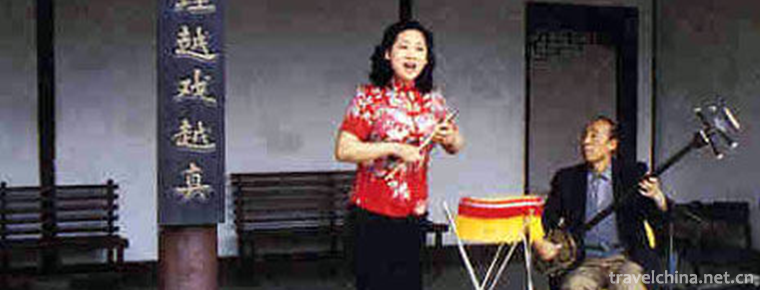
-
Longgong Scenic Area of Anshun City
Located in the southern suburb of Anshun City, Longgong Palace is adjacent to Huangguoshu Scenic Area and 116 kilometers away from Guiyang City, the provincial capital..
Views: 128 Time 2018-12-12 -
Jiaying Scenic Spot
Jiayingguan, commonly known as the Longwang Temple of the Yellow River, is located in Jiayingguan Township, Wuzhong County, Jiaozuo City, Henan Province, China.
Views: 118 Time 2019-01-21 -
Baiyundong Tourist Area Kongshan
Baiyundong in Kongshan Mountain is a national key scenic spot, National Geological Park and national AAAA level scenic spot. Located in Lincheng County of Xingtai City.
Views: 179 Time 2019-01-29 -
Fengyang flower drum
Fengyang flower drum is also known as "flower drum", "beating flower drum", "flower drum gong", "double drum" and so on. Fengyang flower drum originated in Linh.
Views: 330 Time 2019-04-29 -
Haizi Opera
Hezi Opera is one of the traditional operas in Anhui Province. It was named after the pronunciation of the word "sea". It is popular in some areas of Anhui and Henan.
Views: 193 Time 2019-05-03 -
Grey plastic
Gray plastic gray plastic, known as gray batch in ancient times, is the traditional architectural decoration technology in Lingnan area. The material is mainly lime. .
Views: 346 Time 2019-05-04 -
Qiang embroidery
Qiang embroidery evolved and developed on the basis of inheriting the ancient Qiang people's embroidery. Mainly distributed in Wenchuan County, two towns and four townships (Mianfu Town, Weizhou .
Views: 107 Time 2019-06-10 -
June meeting in Regong
Regong June Festival is a unique traditional cultural festival of Tibetan and Tu villages in Tongren County, Qinghai Province. It has been circulated for more than 1400 years. Every June in the Lunar .
Views: 93 Time 2019-06-11 -
Taihao Fuxi Festival
Taihao Fuxi Festival is a traditional folk custom and folk sacrificial activity with a long history. Fuxi was the founder of Chinese civilization. He taught shareholding, tools, farming, marriage, fam.
Views: 163 Time 2019-06-18 -
Wuqiao acrobatics
Wuqiao acrobatics is a traditional folk acrobatics art in Hebei Province. Referring to the "acrobatics town" people are often referred to as Wuqiao County, Cangzhou City, Hebei Province. Acc.
Views: 120 Time 2019-06-29 -
Cheongsam and fan
As the saying goes, the pipa is half covered. What did ancient beauties use to cover their faces? The first reaction must be a fan! Fans are also the most common accessories in ancient times. Men use paper fans and women use round fans. Chinese traditional fan culture .
Views: 352 Time 2020-12-11 -
Neijiang in yuan Ming and Qing Dynasties
In 1279, China was unified and the Yuan Empire was established. After more than 30 years of war between the end of Song Dynasty and the beginning of Yuan Dynasty, the system of Zizhou and Puzhou has not been restored except Jianzhou. In the 22nd .
Views: 281 Time 2020-12-16
